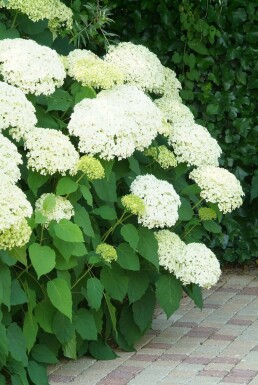Description
Hydrangea arborescens 'Annabelle' | Hydrangea
The Hydrangea arborescens 'Annabelle' is a striking shrub known for its spectacular large white blooms that grace gardens from mid-summer to early autumn. This versatile plant is perfect for borders, group plantings, or as a stunning solitary specimen. Its classic green foliage provides a lush backdrop for the 'Annabelle's' snowball-like flowers, making it a favorite among garden enthusiasts.
This particular Hydrangea variety is prized not only for its beauty but also for its adaptability to a range of soil types and lighting conditions. It exhibits an upright to bushy growth habit and reaches an ultimate height of approximately 1.2 meters, making it a delightful mid-size addition to any garden space.
Key Features
- The Hydrangea 'Annabelle' is renowned for its large, round white flower heads that can reach up to 25 cm in diameter.
- Flowering from July to September, the white flowers remain visually appealing throughout the summer and can even be dried for long-lasting indoor arrangements.
- It has a robust growth form with bright green foliage that remains vibrant from spring through autumn.
- As a deciduous shrub, the Hydrangea 'Annabelle' will shed its leaves in winter, but its strong stems and dried flower heads can provide visual interest even in the colder months.
- While it is not evergreen or fragrant, its striking blooms more than compensate for these traits.
- This Hydrangea variety does not bear fruit, allowing all of its energy to go into producing its magnificent flowers.
Tips
- For optimal growth and bloom production, ensure that 'Annabelle' receives plenty of water, especially in dry periods, as it is not drought resistant.
- Plant your Hydrangea in well-drained soil to prevent root rot. While it can tolerate a range of soil types, proper drainage is crucial.
- 'Annabelle' can flourish in full sun to shade, but in hotter climates, it performs best with some afternoon shade to protect it from intense heat.
- Pruning is minimal for 'Annabelle'. If desired, cut back the stems in late winter or early spring before new growth begins, as it blooms on new wood.
- Propagation through softwood cuttings is straightforward, making it easy to expand your collection or share with fellow gardeners.
- Although 'Annabelle' is hardy, providing mulch around the base of the plant can help retain moisture and protect the roots during extreme temperatures.





























